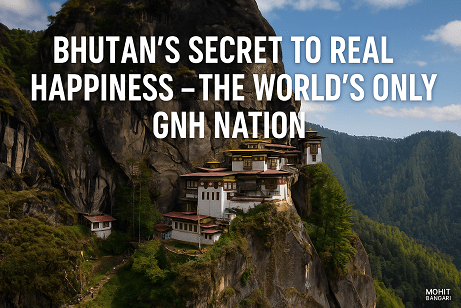By – Mohit Bangari
07 July 2025

Explore Himalaya With Me!!

Bhutan, the peaceful Himalayan kingdom, has become a global example of how to balance tradition, nature, and modern life. While most countries run behind GDP, Bhutan proudly walks its own path with Gross National Happiness (GNH).
But what is this GNH? And why is it being discussed across the world?
Let’s understand this in full detail, along with how it shapes Bhutanese life, tourism, festivals, and more.
Gross National Happiness is Bhutan’s unique model for national progress. It focuses on well-being, spiritual growth, and environmental care instead of just money and markets.
This idea was introduced in 1972 by the Fourth King, Jigme Singye Wangchuck, who famously said,
👉 “Gross National Happiness is more important than Gross Domestic Product.”
Before understanding Bhutan’s way of life, you might want to plan your trip. I have already written a complete guide on budget travel, permits, and entry points.
👉 Read here: How to Travel Bhutan from India – Budget, Permit & Entry Point
Bhutan’s happiness model is built on these four important pillars:
Good Governance
Sustainable Socio-Economic Development
Preservation of Culture
Environmental Conservation
These are further measured by 9 domains and 33 indicators, covering almost every part of human life.
Psychological well-being
Health
Education
Time use
Cultural diversity
Good governance
Community vitality
Environmental resilience
Living standards
These help the government understand what areas need support — not just in economy, but in happiness too.
✅ Environmental Focus – Over 71% of Bhutan is covered with forest. It’s the only carbon-negative country in the world.
✅ Free Healthcare & Education – Bhutan offers both for all its citizens.
✅ Rich Cultural Traditions – From dress to language to festivals, Bhutan protects its identity proudly.
✅ Regulated Tourism – Bhutan promotes “High Value, Low Volume” tourism with a sustainable fee.
✅ Strong Community Bonds – People live close-knit lives with shared values.
Tsechu Festival is the heart of Bhutanese tradition and happiness. It is full of colourful dances, masks, blessings, and spiritual joy.
👉 Read more here: Tsechu Festival 2025 – All You Need to Know
Bhutan conducts a GNH survey every few years. In the last survey:
Over 93.6% Bhutanese people said they are happy
Life expectancy is around 72 years
Literacy is above 71.4%
More than 60% of citizens live in rural areas but with access to basic services
One of Bhutan’s most powerful spiritual spots is Paro Taktsang (Tiger’s Nest Monastery) — a must-visit for anyone looking for peace and adventure.
👉 Don’t miss my detailed guide: Paro Taktsang – A Travel Guide
Bhutan has small population, around 8 lakh people
Deep respect for Buddhism and monastic lifestyle
King’s vision is respected and followed
Modernisation is slow and thoughtful, not forceful
Yes! Especially in hill regions like Uttarakhand, Sikkim, Ladakh, and Arunachal Pradesh, similar GNH-style thinking can work wonders.
✅ Include mental well-being in governance
✅ Focus on green growth
✅ Protect local culture and festivals
✅ Strengthen rural community life
UN supported Bhutan’s GNH model in 2011
March 20 is declared International Day of Happiness
Countries like New Zealand, UAE, and Finland now use happiness-based development indexes
But Bhutan is still the only country where happiness is the base of national planning.
Bhutan’s Gross National Happiness is not just an idea – it is a complete way of living. It shows us that real development is not about income, but inner peace, culture, health, and the environment.
In today’s fast-moving and stressful world, Bhutan gives us a powerful message –
👉 “Slow down, live simply, and stay connected with your roots.”
So next time you plan to visit Bhutan, don’t just explore places — feel the happiness in the air.
You can also explore more on Himalayan treks like Darma Valley, Adi Kailash, and others on my website mohitbangari.com, where I share full guides, routes, permit tips and cultural info.
By – Mohit Bangari
07 July 2025
Do you know about Ramman festival of Salud-Dungra village? It’s one of the intangible world cultural heritage of India in UNESCO. You can read a detailed article on this topic here.


Explore Himalaya With Me!!